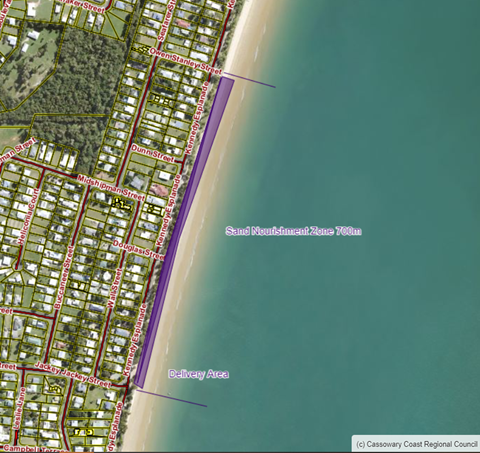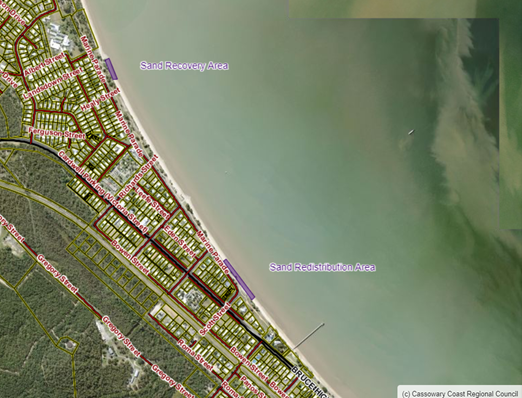Current Coastal Hazard Adaption Projects
Beach nourishment, dune revegetation and restoration:
Coastal nourishment activities are set to take place from early 2024 to May 2025 in known erosion-affected areas of South Mission Beach and Cardwell.
Restoration works will also occur in Cardwell at Tsakiris Street on the current shore protection structures to repair the height and replace failing geo-fabric bags.
In both locations, an ongoing volumetric survey program to monitor and understand the long-term trends of sand movement and allow for targeted placement of imported sand material will occur.
Engagement with Girramay (Cardwell) and Djiru (Mission Beach) traditional owners will be taking place throughout the duration of the project.
-
- A volumetric survey program will be undertaken to monitor and understand the long-term trends of sand movement and allow for targeted placement of imported sand material
- Import and profile 5,000m3 of screened river sand, spread and profile over 550m as shown below, relocate ~1,000m3 up profile
- Engagement with Djiru traditional owners undertaking dune management and rehabilitation in key areas

-
- Undertake ongoing volumetric survey program to monitor and understand long term trends and allow for targeted placement of imported material
- Repair to design height and replace failing geofabric bags at Tsakisiris Street shore protection structures
- Relocate up to 3,000m3 of sand collected from the protection structure to Scott Street area and redistribute over 400m of foreshore
- Engagement with Girramay traditional owners undertaking dune management and rehabilitation in key areas

What is beach nourishment?
Beach nourishment is a process where sand is artificially added to eroding or depleted beaches. The goal is to restore and enhance the beach’s width and volume, protecting valuable coastal properties and maintaining valuable recreation areas.
How does it work?
Sand is dredged from offshore or inland sources. This sand must be of compatible grain size and composition to the existing beach. The dredged sand is then transported to the target beach area via truck. Once on site the sand is distributed and evenly spread and graded to match the natural beach profile.
What are the benefits?
- Provide a buffer against coastal erosion
- Enhances recreational and tourism opportunities
- Protects coastal infrastructure and property
What is Dune rehabilitation?
Coastal dunes are natural barriers that protect inland areas from storm surges, wind and erosion. Dune rehabilitation involves restoring or enhancing these dunes to improve their effectiveness as natural defences.
How are dunes rehabilitated?
There are many viable options for dune rehabilitation some of these include:
- Planting vegetation: Coastal plants like beach grasses and dune stabilisers are planted in and around the dunes. Their deep root systems help bind the sand together and prevent it from being washed away.
- Fencing and sand trapping: Fences and sand trapping structures, such as brushwood fences, are often installed to trap sand and encourage dune formation.
- Access Control: Limiting human and vehicular access to dune areas helps preserve and protect the dune ecosystem.
- Monitoring: Regular monitoring of dune and sand movement is essential to adapt management strategies as needed.
What are the benefits?
- Reinforces natural coastal defences
- Enhances biodiversity by creating valuable habitats
- Provides aesthetic and recreational value
Sand Bypass System Investigation
Sand shifter and sand bypass systems have been employed in high energy coastal situations in southern Queensland where beach nourishment programs became too costly. Council will be investigating the potential implementation of this type of system on the Cassowary Coast. Specifically, the viability at South Mission Beach where ongoing beach nourishment and other activities have been occurring since 2007 to address the long-term erosion trend at this location.
Under future erosion and storm tide risk scenarios identified in the CHAS, this area will require ongoing investment and management of erosion. A long-term solution such as a sand shifter or sand bypass system to address this site would be warranted to reduce recurrent costs.
This concept has not been explored in depth in North Queensland where protected areas are close to the Great Barrier Reef. The report and findings will aim to assist other North Queensland regions in decision making on current and long-term coastal nourishment activities.
What is a Sand Bypass/Shifter System?
A sand bypass system is coastal engineering structure or mechanism designed to mitigate the natural movement of sand along a shoreline. Coastal areas experience the natural transport of sand and sediment due to currents, waves, tides and wind. The movement of sand can result in the erosion of beaches, which can be detrimental to coastal communities and ecosystems.
How Does it Work?
Sand is collected from an area where the sand builds up naturally or from where it is not needed and can be diverted to the location in need of sand.
The collected sand is transported from the intake structure using pumps or conveyors to the discharge structure typically near eroded beaches or areas with sediment depletion.
What are the benefits?
- Protection of coastal infrastructure such as roads and utilities from the damaging effects of storm surges and rising sea levels.
- Preservation of ecosystems ensuring steady flow of sand to support flora and fauna.
Sand bypass systems are a sustainable solution being a cost effective long term approach to coastal management, reducing the need for costly short term .
